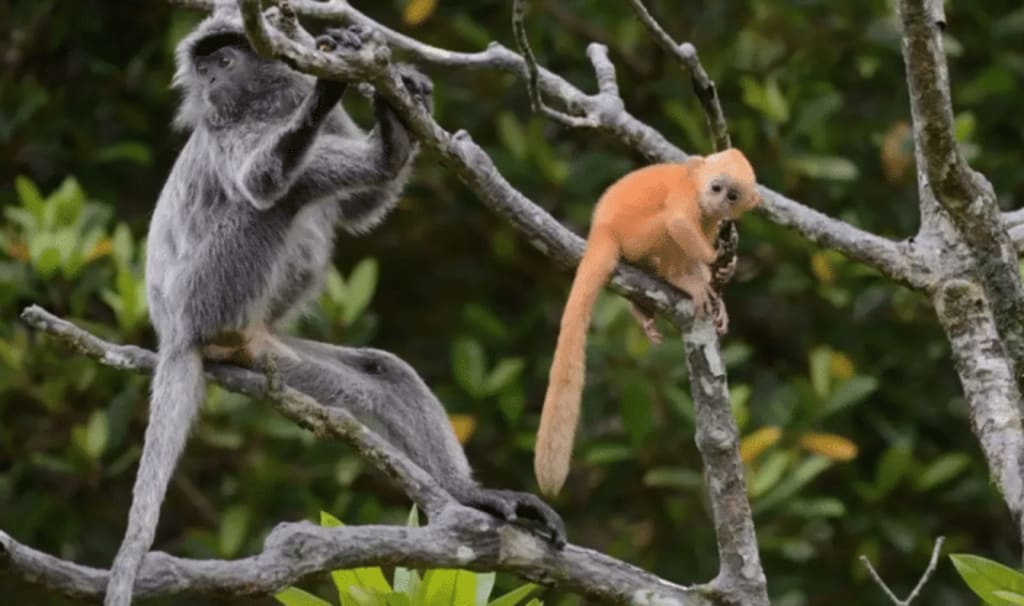'Mysterious hybrid monkey' spotted in Borneo
"Mysterious Hybrid Monkey"

There are more than 300 species of monkeys in the world. Although they are all primates, there will be large differences between different monkeys. For example, different types of monkeys may have large differences in body size. There may also be some new species of monkeys that humans have not discovered yet, according to a study published in "Scientific Reports", scientists have discovered a new species of marmosets in the Brazilian Amazon. In addition to the known species of monkeys, there are also some mysterious monkeys. These monkeys are not just some kind of monkeys, but hybrid monkeys. Scientists have discovered a mysterious hybrid monkey in the forest of Malaysian Borneo. Although the discovery of new monkey species will enrich the planet's species diversity, scientists are deeply concerned after the discovery of hybrid monkeys.
"Mysterious Hybrid Monkey"
Five years ago, someone found a mysterious monkey in the forests of Malaysian Borneo and took a photo of the weird-looking monkey. Then the news reached the scientists, so the scientists began to collect information and photos of the monkey. After identification, it was confirmed that this mysterious monkey was a new species that had never existed on earth. As for the origin of this mysterious monkey, scientists didn't know at the beginning. Is it that this kind of monkey exists on the earth itself, but we haven't discovered it before? Or the offspring of cross-breeding monkeys of different species?
Later, it was confirmed that this mysterious monkey was a hybrid monkey, which was born after the hybridization of two different species, the proboscis monkey and the silver langur. When scientists arrived at the site a few years later to study the monkey, they found the hybrid monkey was feeding a young. It feels incredible. Proboscis monkeys and silver langurs are two different species of monkeys. It stands to reason that the offspring produced by crossbreeding should be sterile, but this mysterious crossbreed monkey is breastfeeding and gave birth to a baby.
Proboscis monkeys and silver langurs are both very typical primates. For example, silver langurs have stomachs similar to those of ruminants like cows. They are the only species in the world that do not belong to the suborder Ruminant but can ruminate. It is also because the silver langur has a powerful stomach that it can digest those cellulose-rich leaves. Not only that, some microorganisms in the stomach of the silver langur can even "detoxify". If the proboscis monkey eats something poisonous, some microorganisms in the stomach of the silver langur will decompose some toxins, which can protect the proboscis monkey.
The discovery shocked biologists that the offspring of hybrid monkeys of different species have the ability to reproduce. At the same time, scientists are deeply concerned, because the birth of this hybrid monkey is ultimately caused by human influence. The expansion of the palm oil industry has caused severe damage to local forest vegetation, and has also led to a severe reduction in the habitat of these primates, by at least 40%, the researchers said. In the case of severe habitat destruction, these different species of primates not only face competition for food and territory, but also competition for mating rights.
Due to the large difference in body size between proboscis monkeys and silver langurs, male proboscis monkeys are larger than male silver langurs. In this regard, male proboscis monkeys have greater advantages, and in the face of many problems The larger proboscis monkeys not only compete for territory, food, but even the mates of the relatively smaller male silver langurs. The result is a mysterious hybrid monkey, and from this point of view, humans can be said to be the "culprit".
Since it is very rare for cross-species hybrids to produce offspring, let alone that offspring can reproduce normally, scientists are worried, but also have a strong interest, hoping to carry out further research on this monkey or this group of monkeys. Research to understand what's going on in these primates.
bird hybrid
The scarlet tanager is mainly distributed in North America, while the situation of the rose-breasted white-breasted finches is relatively complicated. They will nurture their offspring in the cold temperate zone of North America, and will migrate to the tropical regions of the Americas when winter comes. As early as 10 million years ago, the lineages of these two birds diverged and lived in different places. It stands to reason that they would not communicate or even produce love crystals directly. But scientists found that the two birds actually formed a "couple" and gave birth to an offspring.
According to research published in the journal Ecology and Evolution, bird watcher Stephen Gosser spotted a female rose-breasted finches with a male scarlet tanager in western Pennsylvania, USA, and also found young bird. At first, in fact, we did not fully confirm that the young bird was the offspring of their hybridization. It may be that they both nursed the young bird together.
Afterwards, the research team caught the young bird and collected blood samples from the young bird. Through the analysis and comparison of the blood samples, the researchers finally confirmed that this is the young bird produced by hybridization. Researchers say it may have been the sound of the scarlet tanager that attracted the rose-breasted white-breasted finches, and the two fell in love with each other, and then gave birth to a baby, the first documented case of ornithology. Homogeneous hybrids.
About the Creator
adalberto alejandrina
scientific exploration






Comments
There are no comments for this story
Be the first to respond and start the conversation.